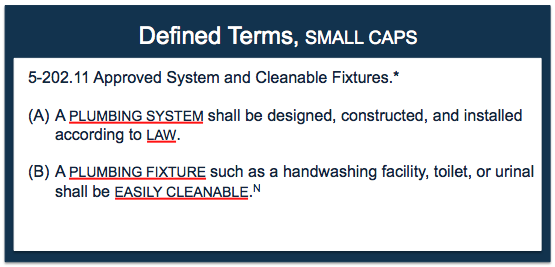Organization of the 1999 Food Code
The Code is a reference document for regulatory agencies responsible for overseeing food safety in retail outlets such as restaurants and grocery stores and institutions such as nursing homes and child care centers. It is neither federal law nor federal regulation and is not preemptive, but may be adopted and used by agencies at all levels of government that have responsibility for managing food safety risks at retail. The Code provides public health and regulatory agencies with practical science-based advice and manageable, enforceable provisions for mitigating risk factors known to contribute to foodborne disease. The Massachusetts Department of Public Health adopted by reference the federal 1999 Code into 590 to ensure that MA regulation will always conform to the federal standard.
Below is a basic organizational outline of the Code.
Preface
This portion of the Code provides background on the nature and extent of foodborne illness, information about the development of the code, and modifications and improvements from the previous edition. Section 8 of the preface also provides information on structure, nomenclature, and methodolody to help assist the user in navigating the various components of the Food Code.
Definitions
Part 1-2 lists and defines terms that apply in the interpretation and application of the Code. Small capital letters are used wherever any word form of a defined term appears within the Code. The word "law" is an all encompassing term in the Code vs. specific to statutes. Its application may relate to plumbing codes or other local or state regulations impacting a food code. As an example, the words underlined in red in the image below, "PLUMBING SYSTEM", "LAW", "PLUMBING FIXTURE" and EASILY CLEANABLE" are all defined in Chapter 1. The term "LAW" means applicable local, state, and federal statutes, regulations, and ordinances (e.g. MA Plumbing Code).

Food Safety Provisions
The major food safety subject areas include personnel, food, equipment/facilities/supplies, as well as compliance and enforcement. Note that personnel was moved up to Chapter 2 because it is often people and personnel practices that cause foodborne disease. "People" Vs. "Food" (as of the 1993 Code) switched sequence as compared to previous codes. That is, "Food" used to be first after definitions. The reason for the shift was to emphasize the importance of the human element and role of fecal/oral contamination.
Chapter 8 deals with compliance and enforcement of the Code. Regulatory authorities can impose additional requirements in addition to the requirements contained in the Code if necessary to protect against public health hazards or nuisances. Variances that waive or modify the requirements of the Code can also be granted by a regulatory authority if such variance does not result in a health hazard or nuisance in the opinion of the regulatory authority.
The table below provides a breakdown of content by chapter.
|
Food Code Chapter |
Content |
|
Supervision; employee health; personal cleanliness; hygienic practices |
|
|
3 - Food |
Characteristics of food; food sources; protection from contamination after receiving; limitation and destruction of organisms of public health concern; food identity an labeling; handling contaminated food; and special requirements for highly susceptible populations |
|
Materials for construction and repair; design and construction; numbers and capacity; location and installation of equipment; cleaning and sanitization of equipment and utensils; laundering; and protection of clean items |
|
|
Water; plumbing system; mobile water tank and mobile food establishment water tank; sewage, other liquid waste, and rainwater; refuse, recyclables, and returnables |
|
|
Materials for construction and repair; design, construction, and installation; numbers and capacity; location and placement; maintenance and operation |
|
|
Labeling and identification; operational supplies and applications; stock and retail sale |
|
|
Code applicability; plan submission and approval; permit to operate; inspection and correction of violations; prevention of foodborne disease transmission by employees |
Annexes
There are seven annexes to the 1999 Code. They were not adopted by 590, but still remain a great resource.
- Annex 1 provides information relating to Compliance and Enforcement.
- Annex 2 contains all references utilized in developing the Code.
- Annex 3 contains the public health reasons for each section of the Code.
- Annex 4 contains information relating to the conduct of inspections, equipment and resources.
- Annex 5 provides HACCP guidelines.
- Annex 6 relates to criteria applicable to certain food process that may result in greater risk of illness.
- Annex 7 contains the forms, guides, and lists that are identified with the Code.



